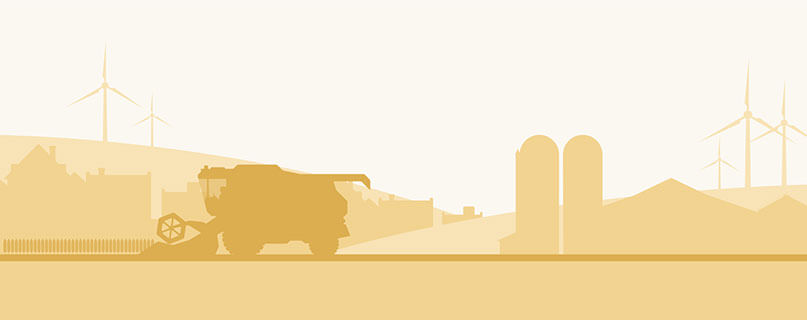Fuels Must Meet Strict Specifications, But What Are They and What Do They Mean?
At Crown Oil, we supply a wide range of fuels that meet one of four specifications: BS 2869; EN 590; EN 15940; and EN 14214. Whether it’s a standard fuel or an alternative fuel, these fuel standards ensure your equipment and vehicles perform optimally when using the highest quality fuel. This guide covers the purpose of each specification, however, for a more detailed look, including the respective technical data for each spec, head to our dedicated fuel specifications page.
What is the BS 2869 fuel specification?
British Standard (BS) 2869 is the UK’s own fuel oil and gas oil specification for heating applications and agricultural machinery. This specification describes middle distillates in crude oil refining that are used for the previously mentioned applications. The BS 2869 standard of fuel has four grades that are optimised for different purposes:
Grade A2 Gas Oil, referring to diesel fuel for off-road engines and machinery;
Grade D Gas Oil, which is diesel fuel for heating applications and older power generators;
Grade C1 Kerosene, premium-grade kerosene for home heating
Grade C2 Kerosene, regular kerosene for home heating applications.
Grade A2 Gas Oil is low in sulphur content (10 ppm) and comprises the majority of red diesel that is supplied across the UK. What’s more, because modern diesel engines are designed with European diesel fuel standard EN 590 in mind, A2 gas oil usually meets these specifications too – unless a lower cetane number or FAME-free content is required. Equipment that runs on A2 grade gas oil includes non-exclusively:
- Tractors (that are operated exclusively off-road).
- Harvesters
- Cranes
- Excavators
- Boilers
- Diesel power generators
- Transport refrigeration units
Grade D Gas Oil is red diesel that is distinguished by a 1000ppm sulphur content and red dye and is used in older machinery and boilers. The sulphur content comes from the element that’s required for lubrication purposes pre-2011. Since then, additives are used instead of sulphur, but legacy machinery, boilers and other equipment still require D Grade red diesel. Uses of Grade D compliant red diesel includes:
- Boilers
- Furnaces
- Older static engines for power generation
If you’re unsure which gas oil grade is best for your hardware, our team of experts are able to help.
Grade C1 Kerosene is the premium grade of kerosene fuel required for domestic oil-fired boilers. It is a cleaner-burning grade of kerosene and has a substantially lower sulphur content than C2 Grade heating oil.
Grade C2 Kerosene is the regular grade of kerosene that makes up the majority of home heating oil as well as being used in industrial processes that require low sulphur content.
BS 2869 compliant fuels supplied by Crown Oil include:
- Red diesel (A2 and D grade diesel gas oil)
- Industrial Heating Oil / IHO (Class I)
- Home heating oil (Grade C2 kerosene)
- Kleenburn Kerosene (Grade C2 kerosene)
- Premium-Grade Kerosene (Grade C1 kerosene)
What is EN 590 fuel specification?
The EN 590 standard is the European diesel fuel specification for low sulphur content diesel and describes the properties diesel fuel must meet if it is to be used in automobiles. This specification of diesel is the grade required by a diesel-engine road vehicle (DERV) and the majority of agricultural machinery. It is also known as Ultra-Low Sulphur Diesel (ULSD).
EN 590 exceeds BS 2869 standards and as a result, all diesel engines in Europe are designed with this in mind. These engines must also meet Euro 6 standards. When you order red diesel (gas oil) from Crown Oil, you’ll receive EN 590 red diesel, the same grade fuel as when you fill your diesel-powered vehicle at the garage (except it’s dyed red).
EN 590 diesel is also designated to have bio content too – currently up to 7% by volume – usually FAME biodiesel. While this is mandated in EN 590, BS2869 differs in that bio content is optional.
Some applications of diesel are beneficial with FAME-free content, such as in agriculture during cold months, to avoid filters becoming blocked during freezing temperatures.
EN 590 grade diesel is used in:
- Lorries
- Vans
- Passenger cars
- Marine craft
- Agricultural vehicles that travel on roads
Learn more about road diesel fuel in our dedicated DERV fuel guide.
Why are EN 590 specs and A2 grade gas oil specs the same?
Since 2011, it’s been a legal requirement for off-road fuel in mobile machinery to comply with the EU’s ULSD regulations – meaning fuel can contain no more than 10ppm of sulphur. DERV already complied with this at the time, the only difference between A2 Grade red diesel and white diesel was the option for different cetane and bio (FAME) content.
This is important as there have been times where modern off-highway machinery designed for use with EN590 was being operated with A2 Grade gas oil, resulting in poor performance.
As a result, and because nearly all gas oil is used for agricultural and commercial use, where modern equipment relies on EN 590 grade diesel, UK refiners focus on producing gas oil that meets the highest specs possible. Gas oil that meets this specification is known as EN 590 gas oil.
When this diesel is designated for on-road or off-road use it becomes marked with a red dye to reflect its lower duty rate.
Our range of fuels that meet EN 590 includes…
Are BS 2869 and EN 590 interchangeable?
BS 2869 is a standard for gas oil, of which diesel fuel is included, while EN 590 refers to the standard of diesel fuel that must be sold across the European Union and other European countries.
EN 590 as a standard, exceeds the BS 2869 requirements and all engines that are sold in Europe are designed with EN 590 spec fuel in mind. So, when a red dye is added to EN 590 diesel, it will qualify as tax reduced A2 Grade gas oil when used in off-road applications. The majority of the red diesel supplied in the UK is rebated EN 590 unless the machinery requires a different blend.
Can BS 2869 Gas Oil be used as road diesel?
We’ve seen that the same fuel can have different names if used in different applications.
We’ve also explained that EN 590 diesel exceeds BS 2869 specs and is also the fuel that most modern diesel engines are designed to use. So when EN 590 grade diesel is marked red, it’s sold as gas oil (red diesel) and taxed accordingly (red diesel has a duty of 11.14p per litre instead of 57.95p per litre that is paid on-road fuel).
Because EN 590 diesel fuel specification exceeds A2 Grade gas oil, there is the ability to have A2 Grade gas oil with a different FAME and cetane value. There is also the possibility that the red diesel is Grade D, which in addition has a higher sulphur content.
In a nutshell, red diesel can have a different sulphur content, bio content, cetane number than road diesel and always has a lower duty than road diesel.
This means red diesel should not be used in road-going vehicles for performance purposes, while the duty difference prohibits its use for legal purposes.
For this reason, you must ensure your vehicle uses the correct specification of fuel. For more information, speak to a professional, such as a Crown Oil team member.
When I buy red diesel from Crown Oil, what grade of fuel am I receiving?
We are committed to providing our customers with the highest grade of red diesel for their requirements. So, if you need EN590 grade red diesel, we will ensure your delivery meets this grade. Otherwise, based on your location, the default red diesel supplied will either be EN590 red diesel or A2 grade red diesel.
Do diesel fuel specifications change?
Diesel fuel (both road diesel and red diesel) are adjusted seasonally to maintain good low-temperature performance. Winter grade is supplied by default from 15 November – 15th March while summer grade diesel is supplied between 16th March and 14th November. This happens automatically at the refinery and there is no need to request this.
You must, however, make sure that you’ve used your summer grade diesel before the winter months to avoid engine problems (winter grade diesel can be used throughout the year, although it is less economical in summer). For more information on red diesel, read our winter vs summer diesel blend guide.
What is EN 15940 fuel standard?
EN 15940 is a European automotive fuel specification for paraffinic diesel fuel that oversees a new generation of cleaner transport fuel for use in road vehicles. It is also known as BS EN 15940 – the BS is for British Standard.
Paraffinic diesel fuel is an alternative fuel that originates from synthesis or hydrotreatment processes (of renewable feedstocks or natural gas) and this specification is aimed at the fuel that is for use in diesel engines and vehicles compatible with paraffinic diesel fuel.
Crown Oil is one of the only fuel suppliers with a vast stock of the renewable paraffinic diesel fuel, Crown HVO on site.
GTL (gas to liquid) is another paraffinic diesel fuel that is graded according to EN15940 specifications. It is similar to HVO in that it is second generation synthetic diesel alternative. However, it is synthesised from gas, and so not made from the same feedstocks as HVO fuel.
Uses of EN 15940 fuel specification fuels (where there is OEM approval):
- Trucks
- Vans
- Power generators
- Heavy duty machinery
- Boilers
- Furnaces
For more information on Crown HVO fuel and what OEM approval it has, read our dedicated HVO fuel FAQ.
What is EN 14214 fuel specification?
EN 14214 is a European standard that describes the requirements and test methods for Fatty Acid Methyl Esters-containing biodiesel (FAME) – the most common type of biodiesel that is blended with petroleum diesel.
Crown Oil products that meet EN 14214 standard:
- Biodiesel (100% FAME content; there is a minimum 10,000-litres order size)
Biodiesel can be used in certain equipment (where there is OEM approval):
- Passenger cars
- Trucks
- Vans
- Power generators
- Heavy duty machinery
- Boilers
- Furnaces
You can learn more about biodiesels in our dedicated biofuels guide and our FAME biodiesel guide.
Fuel Specification Comparison
For a quick overview of the main differences to be found within the different kinds of fuels, here is an easy comparison of what the spec demands. The fuel supplier you choose will have an impact on whether the fuel meets or exceeds these. Our dedicated fuel spec pages will have greater detail on how our fuels meet and exceed the required specifications.
| Grade | Flashpoint (°C) | Sulphur (ppm) | Winter grade CFPP (°C) | Summer grade CFPP (°C) | Colour | Max. Bio content | Cetane number |
| A2 Gas Oil | 56 | 10 | -12 | -4 | Cherry red | 7%* | 45 |
| D Gas Oil | 56 | 1000 | -12 | -4 | Cherry red | 7%* | 45 |
| C2 Heating Oil | 38 | 1000 | NA | NA | Clear | NA | NA |
| C1 Heating Oil | 43 | 20 | NA | NA | Clear | NA | NA |
| EN 590 Gas Oil | 56 | 10 | -12 | -4 | Cherry red | 7% | 45 |
| EN 590 Diesel | 56 | 10 | -15 | -5 | Clear | 7% | 50 |
| EN 14214 Gas Oil | >120 | 10 | -20 | NA | Cherry red | 100% | 51 |
| EN 14214 Diesel | >120 | 10 | -20 | NA | Clear | 100% | 51 |
| EN 15940 Gas Oil | 70 | 5 | -15 to -34 | -15 | Cherry red | 100% | 70 |
| EN 15940 Diesel | 70 | 5 | -15 to -34 | 15 | Clear | 100% | 70 |
* optional
Minimum applicable. Crown Oil product will meet or exceed these amounts. See relevant specification page for full details.
Fuel specification jargon buster
This guide has mentioned a few different types of diesel fuels and technical terms, so here’s a quick breakdown of them.
Cetane number: a cetane number is a number out of 100 that indicates the combustion speed of diesel fuel and as well as the compression needed for ignition, compared to cetane another hydrocarbon which is given a 100 cetane value. The higher the number, the quicker the diesel combusts. A higher cetane number is preferred by high-performance diesel engines. Cetane is the diesel fuel alternative to the octane number in petrol engines.
Diesel is a broad term for any fuel that can run a diesel-fuelled engine, i.e. an engine that combusts fuel using pressure, instead of a spark plug (whether that’s a passenger car or a boiler), while Gas Oil is a broad term for fuel used in heating and non-road applications.
For many off-road applications, there is some crossover and the terms are interchangeable (since gas oil is red diesel), but there are distinctions. The specifications covered in this guide relate to those exact applications.
Within the diesel fuel umbrella of terms, there is petroleum diesel fuel, which makes up the majority of diesel fuel and refers to diesel fuel produced through crude oil refinement. Petroleum diesel must meet either EN 590 or BS 2869 A2 or D, depending on the application.
There is also paraffinic diesel fuel, which refers to synthetically produced diesel (some, like Crown HVO fuel are renewably sourced and called renewable paraffinic diesel, while others, such as GTL, are made from natural gas or other non-renewable sources and are not necessarily renewable, although either type is cleaner burning than petroleum diesel). Paraffinic diesel fuels are considered advanced renewable second-generation fuels and as we mentioned must meet EN 15940.
Moreover, biodiesel refers to first-generation diesel fuel sourced from renewable feedstocks, this includes FAME biodiesel and used cooking oil methyl esters (UCOMe) biodiesel. These are tested to meet EN 14214 specs.
Gas oil is most commonly supplied as petroleum diesel (and in the case of domestic usage, petroleum kerosene) with 7% biodiesel blended in; however in recent years with improved technology, biodiesel such as FAME biodiesel and paraffinic diesel such as HVO fuel have become available as renewable alternatives to fossil fuels, meaning there is more choice for gas oil solutions, which benefits air quality.
Flashpoint: Refers to the lowest temperature at which a fuel produces enough vapour to produce a flammable mixture of gas in the air, once a source of ignition is applied to it. This impacts the ease with which the fuel can ignite.
CFPP: refers to the Plugging point or more technically, the Cold Filter Plugging Point and this is the method used to find the low-temperature operability of fuel – that is to say, the lowest temperature at which that fuel product can operate an engine. Below this temperature, the fuel will begin to wax and cause the diesel engine’s filter to become clogged, or plugged. The machine can no longer operate after this point, and the filter will need to be replaced. During cold winters this can become a problem for farmers, especially in the north of the UK. Fuels are adjusted with additives seasonally, so the plugging point varies by season.
Sulphur content: Refers to the amount of sulphur that is in diesel. Sulphur was originally added in small amounts to diesel to act as a lubricant, reducing engine wear when the fuel passed through the fuel system before being combusted. However, now less harmful additives are added, and there is less sulphur required. However, legacy machinery still requires fuel with higher sulphur content, although thankfully these are a minority now.
And because diesel and gas oil specifications are designed with their respective applications in mind, we have:
Specifications for gas oil (heating and off-road)
- EN 590 Gas Oil (where warranty allows)
- BS 2869 Gas Oil (includes petroleum diesel and kerosene) (where warranty allows)
- EN 15940 Gas Oil (paraffinic diesel) (where warranty allows)
- EN 14214 Gas Oil (biodiesel)(where warranty allows)
Specifications for diesel (on-road fuel for DERVs)
- EN 590 Diesel (Universal)
- EN 15940 Paraffinic diesel (where warranty allows)
- EN 14214 Biodiesel (where warranty allows)
If you would like to order any of our fuels and oils or lubricants for delivery anywhere in the UK, call our fuel specialists today on 0330 123 1444 to learn more and request a quote.





